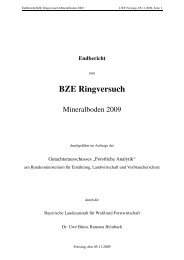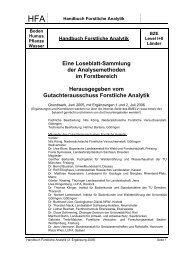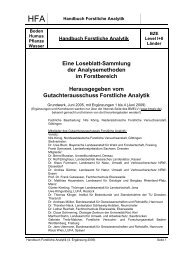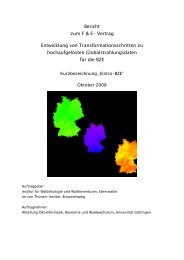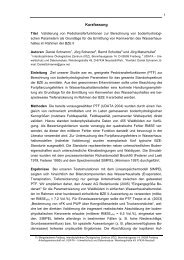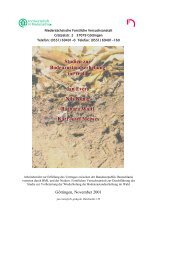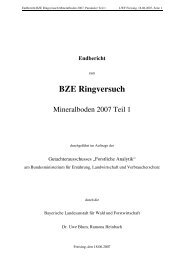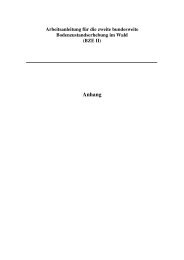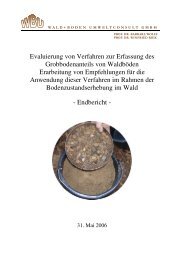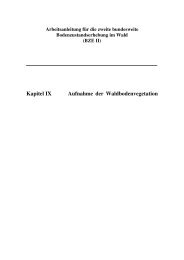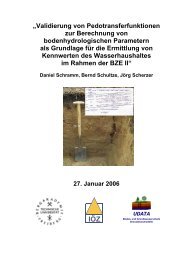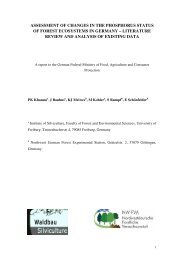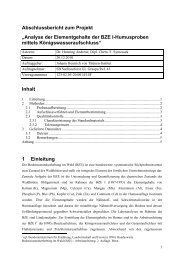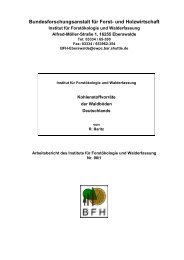assessment of changes in the phosphorus status of forest ...
assessment of changes in the phosphorus status of forest ...
assessment of changes in the phosphorus status of forest ...
Create successful ePaper yourself
Turn your PDF publications into a flip-book with our unique Google optimized e-Paper software.
Table 10. Estimated transfers and <strong>changes</strong> <strong>in</strong> m<strong>in</strong>eral soil P fractions after 28<br />
years (soil depth – 0-60cm) follow<strong>in</strong>g establishment <strong>of</strong> a p<strong>in</strong>e<br />
plantation. Details <strong>of</strong> <strong>the</strong> method <strong>in</strong> <strong>the</strong> text and Table 8 (taken from<br />
Richter et al. 2006)<br />
P flux or component 28-year change <strong>in</strong><br />
soil P (kg/ha)<br />
Total P <strong>changes</strong> <strong>in</strong> m<strong>in</strong>eral soil (retention <strong>in</strong> vegetation and<br />
<strong>forest</strong> floor, m<strong>in</strong>us atmospheric <strong>in</strong>puts)<br />
Soil ga<strong>in</strong>s (+) and losses (-)<br />
82.5<br />
Res<strong>in</strong> Pi 0<br />
NaHCO3 – Pi +22.0<br />
NaHCO3 – Po 0<br />
NaOH – Pi -3.4<br />
NaOH – Po -22.8<br />
1 M HCl – Pi -52.2<br />
Residual P 0<br />
Total P (sum <strong>of</strong> statistically significant <strong>changes</strong>) -63<br />
3.2.5 Soil P measurement by sequential fractionation<br />
A chemical fractionation method for P <strong>in</strong> soils was <strong>in</strong>itially provided by Chang and<br />
Jackson (1957) which was later modified (Hedley et al. 1982) to better represent<br />
plant-available and non-plant-available P forms <strong>in</strong> soils (Tiessen and Moir 1993)<br />
(Table 8). This method is commonly modified to suit <strong>the</strong> aim <strong>of</strong> a study, site<br />
conditions and laboratory facilities. The fractionation also provides a valuable <strong>in</strong>dex<br />
<strong>of</strong> <strong>the</strong> relative importance <strong>of</strong> biological processes to soil <strong>phosphorus</strong> content across a<br />
soil wea<strong>the</strong>r<strong>in</strong>g gradient (Cross and Schles<strong>in</strong>ger 1995).<br />
The fractionation scheme <strong>in</strong>volves <strong>the</strong> sequential extraction <strong>of</strong> (a) soluble and<br />
exchangeable P by anion exchange res<strong>in</strong> or iron oxide-impregnated filter paper strip<br />
(Menon et al. 1989); (b) readily available forms by sodium bicarbonate to remov<strong>in</strong>g<br />
<strong>the</strong> <strong>in</strong>organic P (Pi) adsorbed to iron and alum<strong>in</strong>ium surfaces, and organic P (Po),<br />
which may <strong>in</strong>clude P from lysed microbial cells, nucleic acids, phospholipids etc.; (c)<br />
moderately to strongly bound forms by sodium hydroxide which may remove Pi<br />
reta<strong>in</strong>ed by iron and alum<strong>in</strong>ium, and organic P stabilized partially as soil organic<br />
matter; (d) moderate to strongly bound to calcium by 1 M hydrochloric acid (HCl);<br />
65



